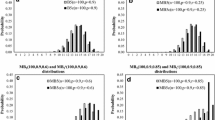Abstract
Consideration was given to the so-called “Polesskii estimates” which define new, more accurate reliability boundaries of the random binary systems as compared with the classical Esary-Proshan estimates. As was later shown, these estimates can be further refined. By giving a simplified, that is, purely applied, interpretation of the formal Polesskii rules, the present author demonstrated that Polesskii's concepts in principle enable one to reach the maximum disentanglement of clutters, thus substantially approaching the reliability boundaries of the random binary systems. The results of comparing the Polesskii estimates with other possible lines to attack the approachment of the boundaries of combinatorial reliability of the random binary systems were presented.
Similar content being viewed by others
REFERENCES
Polesskii, V.P., Clutter Disentanglement, Correlational Inequalities, and Boundaries of Combinatorial Reliability, Probl. Peredachi Inf., 1997, vol. 33, no.3, pp. 50–70.
Esary, J. and Proshan, F., Coherent Structures of Non-Identical Components, Technometrics, 1963, vol. 5, no.2, pp. 191–209.
Kostrov, V.O., Using the Polesskii Estimates to Calculate Communication Network Reliability, Elektrosvyaz', 2001, no. 11, pp. 42–46.
Filin, B.P. and Shaparev, A.V., On an Approach to Calculating the Probability of Retaining the Maximum Flow, Avtom. Telemekh., 2001, no. 1, pp. 102–117.
Filin, B.P., On the Principle of Duality in Analysis of Structural Reliability of Complex Systems, Avtom. Telemekh., 1989, no. 6, pp. 158–172.
Moore, E. and Shannon, C.E., Reliable Circuits of Nonreliable Networks, in Raboty po teorii informatsii i kibernetike (Works on Information Theory and Cybernetics), Moscow: Inostrannaya Literatura, 1963, pp. 114–153.
Zatsarinnyi, A.A., System Approach to Design, Introduction and Development of the Modern Corporate Telecommunications Networks, Vedomstv. Korporativnye Sistemy Seti, 2002, no. 3, pp. 110–116.
Nadezhnost' tekhnicheskikh sistem. Spravochnik (Reference Book on Reliability of Technical Systems), Ushakov, I.A., Ed., Moscow: Radio i Svyaz', 1985.
Ushakov, I.A., Ed., Harrison, R., Coed., Handbook of Reliability Engineering, New York: Wiley, 1994.
Gadasin, D.A. and Gadasin, V.A., Reliabillity of Bipolar Additively-structures Networks. Avtom. Telemekh., 1999, no. 10, pp. 164–179.
Belikov, A.I. and Filin, B.P., On Estimating the Series of Distribution of the Existence Probability of Simple Chains in the Bipolar Network, Avtom. Telemekh., 1991, no. 11, pp. 164–176.
Rainschke, K. and Ushakov, I.A., Otsenka nadezhnosti sistem s ispol'zovaniem grafov (Using Graphs to Estimate System Reliability), Moscow: Radio i Svyaz', 1988.
Shoigu, S.K., Our Priorities, Spasatel' MChS Rossii, 2003, no. 23, p. 1.
Litvak, E.I., Generalized Triangle-Star Transformations in the Studies of Complex Networks, Izv. Akad. Nauk SSSR, Tekh. Kibern., 1981, no. 1, pp. 21–24.
Litvak, E.I. and Ushakov, I.A., Estimating Parameters of Complex-structure Networks, Izv. Akad. Nauk SSSR, Tekh. Kibern., 1984, no. 3, pp. 15–19.
Netes, V.A. and Filin, B.P., Consideration of Node Failures in Network-Reliability Calculation, IEEE Trans. Reliability, 1996, vol. 49, no.1, pp. 67–68.
Krivulets, V.G., On Estimating the Esary-Proshan Estimates in the Problems of Structural Analysis of Communication Networks, Tr. 55-i Nauchnoi sessii, posvyashchennoi Dnyu radio (Proc. 55 Scientific Session Devoted to the Day of Radio), Moscow, 2000.
Garey, M.L. and Johnson, D.S., Computers and Intractability: A Guide to the Theory of NP-Completness, San Francisco: Freeman, 1979. Translated under the title Vychislitel'nye machiny i trudnoreshaemye zadachi, Moscow: Mir, 1982.
Venttsel', E.S., Teoriya veroyatnostei (Probability Theory), Moscow: Nauka, 1964.
Busacker, R.G. and Saaty, T.L., Enliche Graphen und Netzwerke, Munchen: Oldenbourg, 1968. Translated under the title Konechnye grafy i seti, Moscow: Nauka, 1974.
Filin, B.P., Metody analiza strukturnoi nadezhnosti setei svyazi (Methods of Analysis of Structural Reliability of Communication Networks), Moscow: Radio i Svyaz', 1988.
Bogatyrev, V.A., On Reliability Calculations of Communication Networks by the Totality of Paths, Elektrosvyaz', 1981, no. 2, pp. 42–44.
Mizin, I.A., Bogatyrev, V.A., and Kuleshov, A.P., Seti kommutatsii paketov (Packet Switching Networks), Moscow: Radio i Svyaz', 1986.
Filin, B.P., On the Method of Rapid Estimation and Coefficient of Potential Structural Impregnability of Communications in Complex Systems, Avtom. Telemekh., 1994, no. 5, pp. 158–182.
Dudnik, B.Ya. and Filin, B.P., Applying the Method of Bipartite Graphs to Estimation of Complex System Reliability, Avtom. Telemekh., 1981, no. 12, pp. 154–167.
Netes, V.A. and Filin, B.P., Analysis of Reliability and Survival Capability of Communication Networks by the “MAMONA” Software System, Proc. X Scientific Session Devoted to the Day of Radio, Moscow, 1992, p. 1.
Tul'skii, N.V., Using Direct Enumeration of Simple Chains to Estimate Reliability of Communication networks, Elektrosvyaz', 1994, no. 5, pp. 20–23.
Pechenkin, A.N. and Filin, B.P., An Algorithm for Ordered Generation of Communication Paths, Elektrosvyaz', 1996, no. 6, pp. 22–24.
Netes, V.A. and Filin, B.P., Calculating the On-line Availability Ratio of Network-structured Systems, Avtom. Telemekh., 1992, no. 9, pp. 179–186.
Ershov, A.V., Netes, V.A., and Filin, B.P., Calculation of the Probabilty of Providing the Required Throughput of a Bipolar network with Nonreliable Elements, Avtom. Telemekh., 1996, no. 3, pp. 161–184.
Zykov, A.A., Teoriya grafov (Graph Theory), Novosibirsk: Akad. Nauk SSSR, 1964.
Butrimenko, A.V., On Seeking the Optimal Paths, Izv. Akad. Nauk SSSR, Tekh. Kibern., 1964, no. 6, pp. 55–58.
Author information
Authors and Affiliations
Additional information
__________
Translated from Avtomatika i Telemekhanika, No. 9, 2005, pp. 149–189.
Original Russian Text Copyright © 2005 by Filin.
Rights and permissions
About this article
Cite this article
Filin, B.P. On Extreme Disentanglement of Clutters in the Polesskii Estimates of the Boundaries of Combinatorial Reliability of Random Binary Systems. Autom Remote Control 66, 1496–1532 (2005). https://doi.org/10.1007/s10513-005-0188-9
Received:
Issue Date:
DOI: https://doi.org/10.1007/s10513-005-0188-9




